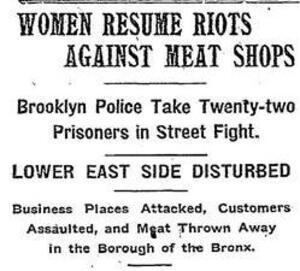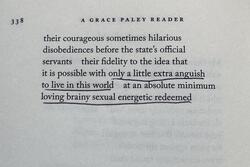The Real Housewives of the Lower East Side
One hundred and ten years ago today, something surprising happened. Jewish immigrant housewives in New York City—concerned and angry about a sharp rise in the price of kosher meat from 12 cents to 18 cents per pound—launched a kosher meat boycott that lasted nearly a month, spread to several other boroughs of New York, sparked violent riots and arrests, and attracted much media attention before ending with the successful lowering of meat prices.
Unlike most other immigrant activists of the period, these boycotters were not young workers—they were housewives with children. Their average age was 39, and most had four or more children at home. Though women had historically been involved in popular protests around issues like food prices, the kosher meat boycott of 1902 stands out as a pioneering example of women’s strategic political organizing and effective use of local networks.
In early May of 1902, small butchers had responded to the skyrocketing price of kosher meat by boycotting the wholesalers (known as the Meat Trust) in an attempt to lower prices. But when the butchers settled with the Meat Trust without achieving a price reduction, housewives of the Lower East Side decided to take matters into their own hands.
Armed with the knowledge of their own consumer power and with the organizing tactics of the labor movement, they canvassed their neighborhood and succeeded in bringing thousands of women into the streets on May 15 to declare a boycott. The protesters broke into butcher shops, confiscated meat from customers, and engaged in violent clashes with police. Approximately 70 women and 15 men were arrested.
But these women were not simply angry, spontaneous rioters—they were political actors making strategic, planned calculations. Following the riot, the committee of women leading the boycott held a mass meeting to gather support and to strategize. On May 16, they went from house to house to organize their fellow housewives and to collect funds to pay arrest fines and reimburse customers whose meat had been taken in the riot. They set up pickets in front of each butcher shop. Rioting continued that day, and more than 100 people were arrested. The boycott spread to the Bronx and to Harlem, where local women took up the organizing of their own neighborhoods.
The Sabbath brought no rest to the boycott leaders. Not only did they use communal surveillance to enforce the boycott—checking the cholent pots of their neighbors for the banned meat—but they also went from synagogue to synagogue to plead their cause. Drawing on the custom that allowed interruption of the Torah service for a matter of social justice (a tactic that, IMHO, should be revived), the women came down from the women’s section, calling for support of the boycott.
By the following day, most of the kosher butcher shops had succumbed to the boycott and closed. The boycott had also spread to Brooklyn. That night, more than 500 women met to organize and strategize further, now under the name of the Ladies’ Anti-Beef Trust Association. The Ladies’ Anti-Beef Trust Association organized house-to-house patrols and surveillance of butcher shops. They assigned committees to visit labor union meetings and mutual aid societies and to plan cooperative kosher meat stores.
At this point, male communal leaders decided it was time to assert their own direction over the boycott. They gathered men representing synagogues, mutual aid societies, unions, and other organizations, and formed the Allied Conference for Cheap Kosher Meat, telling women to leave the fighting to them. Undeterred, women continued their tireless neighborhood organizing.
Overall, the boycott met widespread support throughout the community. Rabbis addressed it from their pulpits; crowds came to the courthouse to support the arrested women. The boycott received near-daily coverage in the New York Times and the New York Herald (though not all of it positive) and Jewish newspapers—both the socialist Forward and the Orthodox Yiddishes Tageblat—covered the boycott sympathetically. Labor unions lent their support, too.
The strike officially ended on June 5, 1902, and retail meat prices returned to 14 cents per pound. The Ladies’ Anti-Beef Trust Association disbanded, but the kosher meat cooperatives that had been established during the boycott continued to operate. The boycott had been a success, though its impact was not permanent—meat prices eventually began to rise again.
But the success of the boycott should not be assessed only in terms of kosher meat prices. The housewife boycotters modeled an approach to community organizing that set an important precedent, emerging to effective use again in the rent strikes of 1904 and 1907, and in the kosher meat boycotts of 1917 and 1935. They also helped broaden the conversation about labor activism to include housewives, women’s roles as consumers and domestic managers, and the power of informal neighborhood networks. The boycotters used explicitly political language in their fight: they referred to themselves as strikers, called those who broke the boycott scabs, and referred to freedom of speech when protesting police disruption of their gatherings. Despite difficult conditions, they sustained their activism and grew their organization over the course of several weeks. The important lessons the boycott taught about women’s political potential also likely shaped the political consciousness of their daughters, many of whom were working in the garment industry during the “Uprising of the 20,000” in 1909-1910.
I’ve had the pleasure of re-immersing myself in this story of the kosher meat boycott recently as I’ve been developing the newest part of the Living the Legacy social justice education project on Jews and the Labor Movement (stay tuned for its launch in the fall!). More than 100 years later, we still need to be reminded that “workers” should include those in the domestic sphere, that housewives can be political, that there are fewer things stronger than neighborhood networks, and that sometimes, it’s even ok to interrupt the Torah service.








Great piece, Judith - thanks for sharing this story!